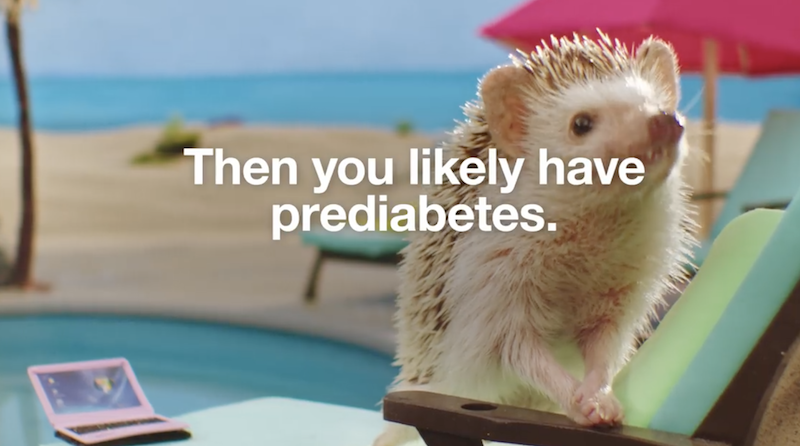A national ad campaign uses hedgehogs living their best life on vacation to get people to take a 1-minute test about how many risk factors they have for prediabetes. Screenshot
Would you watch a one-minute video about the risk factors of prediabetes … if the video featured little hedgehogs living their best life on vacation? The CDC hopes so.
The campaign, which also has a doggo ad for those surfing the web to watch dog antics, is a joint collaboration by national organizations because 84 million Americans are thought to be prediabetic.
But 90 percent of them don’t know it — so maybe using animals is the way to go, said Ann Albright, director of the Center for Disease Control and Prevention’s division of diabetes translation, speaking in Nashville on May 17.
Tennessee can be referred to as the “belt buckle of the Type 2 diabetes belt:” the prevalence of adults with Type 2 diabetes has surged from 5.4 percent of the population in 1990 to 12.7 percent in 2015.
The impact of the disease has a “tremendous impact economically” and on quality of life, said Dr. Morgan McDonald, director of family health and wellness at the Tennessee Department of Health.
»Watch the hedgehogs
The two spoke to a group at Belmont University about the federal and state governments’ efforts to launch a year-long lifestyle intervention program for people who could potentially prevent the onset of Type 2 diabetes, or manage the disease from leading to an array of complications ranging from blindness to heart disease.
The YMCA and NashvilleHealth co-hosted the Clinic to Community: A Health Summit to connect business and non-profit leaders to clinicians and public health researchers who are trying to unfurl programs that to do the nearly impossible: change people’s behavior.
“Unless we as a country do a better job at cracking that nut we shouldn’t do research on anything that requires people to (change),” said Albright.
‘If we all became a little adventurous’
Speakers highlighted the success of a yearlong Diabetes Prevention Program, designed by the CDC, at getting involved in people’s lives with a high-touch approach that encourages healthier behaviors to either reverse or stave off progression of the disease.
The research began in 2002, said Albright, and the program hit milestones every few years until 2010 when the CDC received Congressional authority to take it across the country.
But the program needs committed and trained community partners — Albright said the Y is instrumental in many places — to reach people and make sure they stick through the 12-month program.
There are 60 local offshoots of the Diabetes Prevention Program in 18 counties around the state, primarily clustered in the largest metro areas. But the state wants to get more programs in rural areas where the burden is often heavier, said McDonald.

Partners, such as the Y and employers, are essential given the role they play in people’s lives and the challenges of getting people engaged and retained in programs.
“I have a responsibility to help you be your best self. I’m not going to be your doctor. I’m only one part of that bridge,” said Anne Oxrider, senior vice president and senior benefits consultant at Bank of America.
Ted Cornelius, vice president of health innovation at the YMCA of Middle Tennessee, said the Y is looking for more partners on the diabetes prevention program to reach further into the community. Not every organization can run all of the logistics of the program so he encouraged community organizations, businesses or faith-based groups to find an area where they can pitch in and do it.
“It requires an organization like the Y to partner with doctors, insurers and others to look at the continuum of care for the patients we serve,” said Cornelius. “We are all working to support each others patients — sometimes we’re just not doing it in an intentional way.”
The prospect of improving, or even making a dent in, overall health isn’t easy or fast.
The variables that determine health are scattered across people’s lives and environment, the speakers noted. They aren’t simple fixes and organizations that want to pitch in can be daunted, said Denise Costanza, vice president of health strategies at the American Heart Association.
Former Sen. Bill Frist said Nashville’s “got one of the worst transportation systems in America given our size” — and it’s a challenge when thinking about how to to successfully connect people to healthier options or consistent care.
But Costanza told the audience, “if we all became a little adventurous and reach out to areas that might not be safe or traditional,” then an organization can find a “niche and problem to solve.”
•


You must be logged in to post a comment.